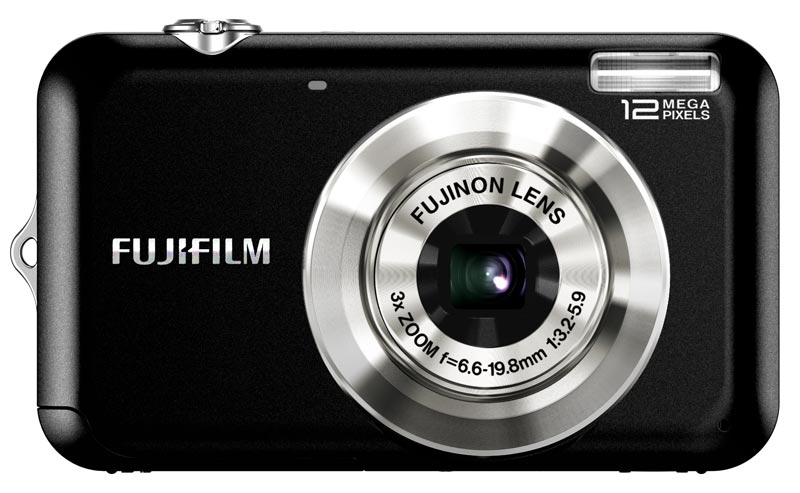Fujifilm FinePix JV100 Review
Fujifilm FinePix JV100 Review
Does Fujifilm entry-level offering, the Fujifilm JV100, manage to combine style, technology and a tempting price tag?

Verdict
Pros
- Very good detail, small and lightweight
Cons
- Battery cover, poor flare control, only stabilisation system is sensitivity based
Key Specifications
- Review Price: £75
Announced at the beginning of the year, Fujifilm’s JV range aims to combine the latest in camera technology with style and an attractive price tag. So far the line has welcomed three such models, including the Fujifilm JV100 which, as the range’s most junior model, can be found for as little as £75. This certainly makes it one of the cheapest compacts currently available – but can Fujifilm deliver on its other two promises?
Fujifilm JV100 build and handling
Despite the inclusion of some ‘latest technologies’, the Fujifilm JV100 is built around a fairly standard core of a 12.2MP sensor and 3x optical zoom lens. The optic begins at 37mm and ends at 111mm, and so isn’t particularly suited for any photography which requires a wide angle of view.
There’s also no image stabilisation with either the lens or the sensor, but a sensitivity-based system is available, which adjusts the ISO for a faster shutter speed where necessary.
In line with practically all other recent compacts, the Fujifilm JV100 captures HD-quality movies at a maximum resolution of 1,280 x 720p. These are limited to 15 minutes in length, during which the optical zoom may be called upon, though other movie resolutions are also available should you not require HD capture.
There’s little surprise at the inclusion of the now-standard Face Detection, but Fujifilm has complemented this with Blink Detection and a Smile and Shoot mode. The former alerts the user when a blinking subjects has been detected, while the latter automatically trips the shutter release once the subject can be seen smiling.
There’s also a Scene Detection mode which analyses the elements within a scene before choosing one of six categories. This, Fujifilm claims, allows it to select the most appropriate settings with regards to colour, depth of field and white balance, among other options.
Finally, the rear offers a 2.7in LCD screen, which displays images and video at a resolution of 230,000 dots, and covers approximately 96% of the scene. As with many other compacts the model is compliant with the SD and SDHC memory card formats, but not the latest high-capacity SDXC variant which is steadily becoming available.
At just 18.5mm thick and weighing little over 100g, the Fujifilm JV100 is designed to be convenient in all manner of photographic situations. Sadly, the same cannot be said for the design of the controls themselves, some of which recessed far too deeply into the body for any comfortable operation to take place. The mode dial, for example, is afflicted by this, while its looseness means it is often unintentionally turned out of its set position, particularly as it is positioned exactly where the thumb naturally rests. Also disconcerting the flimsiness of the battery cover, which is pretty poor even when the model’s low asking price is considered.
The camera starts up in good time and powers down about as quickly, and although focusing is a little on the noisy side, the camera does well to focus quickly on a number of different subjects. In brighter conditions it can be a little difficult to see exactly when the camera has focused, as the screen struggles to display a clear view, although this criticism applies to many of the JV100’s peers.
Fujifilm JV100 image quality
While not perfect, the Fujifilm JV100 does much to impress with regards to its images. In fact, at times it can be difficult to believe that such a cheap camera is capable of capturing such a high level of detail. The level of fine detail – particularly in the centre of the frame – is impressive, while colour is very good and exposures consistent. On lower sensitivities noise is minimal, and any noise reduction that is being applied has little adverse effects. Images also display good sharpness – perhaps on the cusp of being a little too sharp, but this is only noticeable at 100% viewing.
While some purple fringing and general chromatic aberrations are visible in scenes with high contrast, overall chromatic aberrations are well controlled. Sharpness is also well maintained to the edges of the frame.
It’s in good light, however, that the camera also shows its shortcomings. It’s perhaps just as well that camera’s lens starts from 37mm as even at this focal length the camera shows its poor control over flare, which gives rise to a general loss of contrast. The camera’s limited dynamic range is also clear with the loss of highlight detail, while its propensity to use flash in macro mode can result in unnaturally looking close up images. Throughout the test the red-eye reduction feature also failed to completely eliminate red-eye in some subjects.
Verdict
The Fujifilm JV100’s design issues are unfortunate, as otherwise it ticks many boxes for a budget compact. It’s cheap, small and lightweight, with a pleasing design, and is capable of very good image quality. Aside from the lack of a HDMI port and its flimsy battery cover, my only other gripe is with the sensitivity-based image stabilisation, which could be improved upon with a sensor- or lens-based system.
Trusted Score
Score in detail
-
Value 10
-
Design 8
-
Features 8
-
Image Quality 9
-
Performance 9

